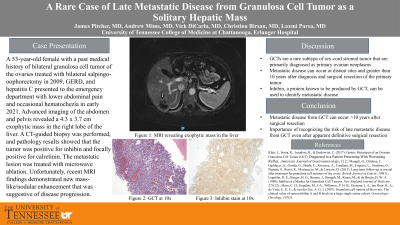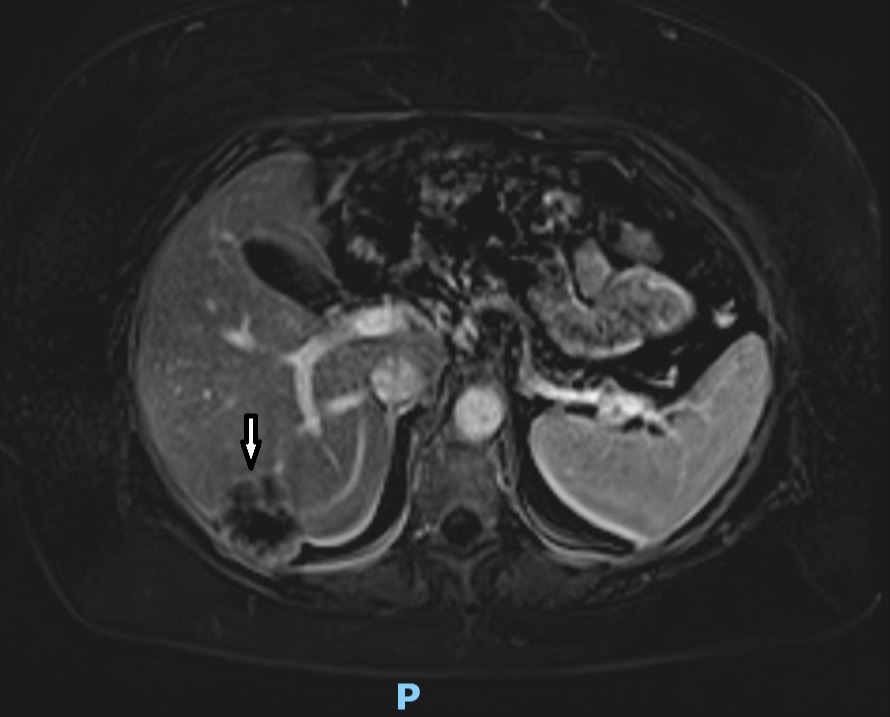Back


Poster Session B - Monday Morning
Category: Liver
B0581 - A Rare Case of Late Metastatic Disease From Granulosa Cell Tumor as a Solitary Hepatic Mass
Monday, October 24, 2022
10:00 AM – 12:00 PM ET
Location: Crown Ballroom

Has Audio

James Pitcher, II, MD
University of Tennessee Health Science Center
Chattanooga, TN
Presenting Author(s)
James Pitcher, MD1, Andrew Mims, MD1, Vick DiCarlo, MD1, Laxmi Parsa, MD1, Christina Birsan, MD2
1University of Tennessee Health Science Center, Chattanooga, TN; 2Erlanger Medical Center, Chattanooga, TN
Introduction: Granulosa Cell Tumor (GCT) is a rare type of sex cord-stromal neoplasm that often has an indolent course. These tumors make up 2-5% of all ovarian malignancies. When they do metastasize, it is often within the lower abdomen and pelvis. Recurrence of the disease often occurs within 10 years of the diagnosis, but there is potential for recurrent disease beyond this timeframe. Because of the risk of late recurrence with GCT, continued surveillance is crucial beyond surgical resection of the primary tumor. Inhibin has been shown to be a valid marker in both management of primary disease and surveillance for late recurrence. The overall prognosis for GCT is generally favorable given that the disease is detected early. Surgical intervention is mainstay of treatment for these tumors, although systemic chemotherapy is considered in nonresectable or advanced cases.
Case Description/Methods: A 53-year-old female with a past medical history of bilateral GCT of the ovaries status post bilateral salpingo-oophorectomy (2009), gastroesophageal reflux disease, and Hepatitis C presented to the emergency department with lower abdominal pain and occasional hematochezia in 2021. She was discharged with referrals for further evaluation. During her work up, she underwent a CT scan that revealed a 4.3 x 3.4 cm exophytic mass in the right lobe of the liver. Further evaluation with MRI showed that the mass was irregular and exophytic with minimally increased size, now measuring 4.6 x 3.7 cm. A CT-guided biopsy showed that the tumor was positive for inhibin, suggestive of metastatic GCT. The solitary hepatic metastasis was treated with microwave ablation.
Discussion: GCTs are a rare subtype of sex-cord stromal tumor that are typically primary ovarian neoplasms and often have an indolent course and favorable prognosis, although there is evidence that metastatic disease can occur at distant sites and greater than 10 years after diagnosis and surgical resection of the primary tumor. This case describes the recurrence of disease as a solitary hepatic mass. Diagnostic confirmation was made by CT-guided biopsy that found the presence of inhibin, a protein known to be produced by GCT. This case highlights the importance of long-term surveillance in patients with a history of GCT beyond surgical resection and undetectable disease activity.

Disclosures:
James Pitcher, MD1, Andrew Mims, MD1, Vick DiCarlo, MD1, Laxmi Parsa, MD1, Christina Birsan, MD2. B0581 - A Rare Case of Late Metastatic Disease From Granulosa Cell Tumor as a Solitary Hepatic Mass, ACG 2022 Annual Scientific Meeting Abstracts. Charlotte, NC: American College of Gastroenterology.
1University of Tennessee Health Science Center, Chattanooga, TN; 2Erlanger Medical Center, Chattanooga, TN
Introduction: Granulosa Cell Tumor (GCT) is a rare type of sex cord-stromal neoplasm that often has an indolent course. These tumors make up 2-5% of all ovarian malignancies. When they do metastasize, it is often within the lower abdomen and pelvis. Recurrence of the disease often occurs within 10 years of the diagnosis, but there is potential for recurrent disease beyond this timeframe. Because of the risk of late recurrence with GCT, continued surveillance is crucial beyond surgical resection of the primary tumor. Inhibin has been shown to be a valid marker in both management of primary disease and surveillance for late recurrence. The overall prognosis for GCT is generally favorable given that the disease is detected early. Surgical intervention is mainstay of treatment for these tumors, although systemic chemotherapy is considered in nonresectable or advanced cases.
Case Description/Methods: A 53-year-old female with a past medical history of bilateral GCT of the ovaries status post bilateral salpingo-oophorectomy (2009), gastroesophageal reflux disease, and Hepatitis C presented to the emergency department with lower abdominal pain and occasional hematochezia in 2021. She was discharged with referrals for further evaluation. During her work up, she underwent a CT scan that revealed a 4.3 x 3.4 cm exophytic mass in the right lobe of the liver. Further evaluation with MRI showed that the mass was irregular and exophytic with minimally increased size, now measuring 4.6 x 3.7 cm. A CT-guided biopsy showed that the tumor was positive for inhibin, suggestive of metastatic GCT. The solitary hepatic metastasis was treated with microwave ablation.
Discussion: GCTs are a rare subtype of sex-cord stromal tumor that are typically primary ovarian neoplasms and often have an indolent course and favorable prognosis, although there is evidence that metastatic disease can occur at distant sites and greater than 10 years after diagnosis and surgical resection of the primary tumor. This case describes the recurrence of disease as a solitary hepatic mass. Diagnostic confirmation was made by CT-guided biopsy that found the presence of inhibin, a protein known to be produced by GCT. This case highlights the importance of long-term surveillance in patients with a history of GCT beyond surgical resection and undetectable disease activity.

Figure: MRI of the abdomen showing metastatic granulosa cell tumor (arrow)
Disclosures:
James Pitcher indicated no relevant financial relationships.
Andrew Mims indicated no relevant financial relationships.
Vick DiCarlo indicated no relevant financial relationships.
Laxmi Parsa indicated no relevant financial relationships.
Christina Birsan indicated no relevant financial relationships.
James Pitcher, MD1, Andrew Mims, MD1, Vick DiCarlo, MD1, Laxmi Parsa, MD1, Christina Birsan, MD2. B0581 - A Rare Case of Late Metastatic Disease From Granulosa Cell Tumor as a Solitary Hepatic Mass, ACG 2022 Annual Scientific Meeting Abstracts. Charlotte, NC: American College of Gastroenterology.
